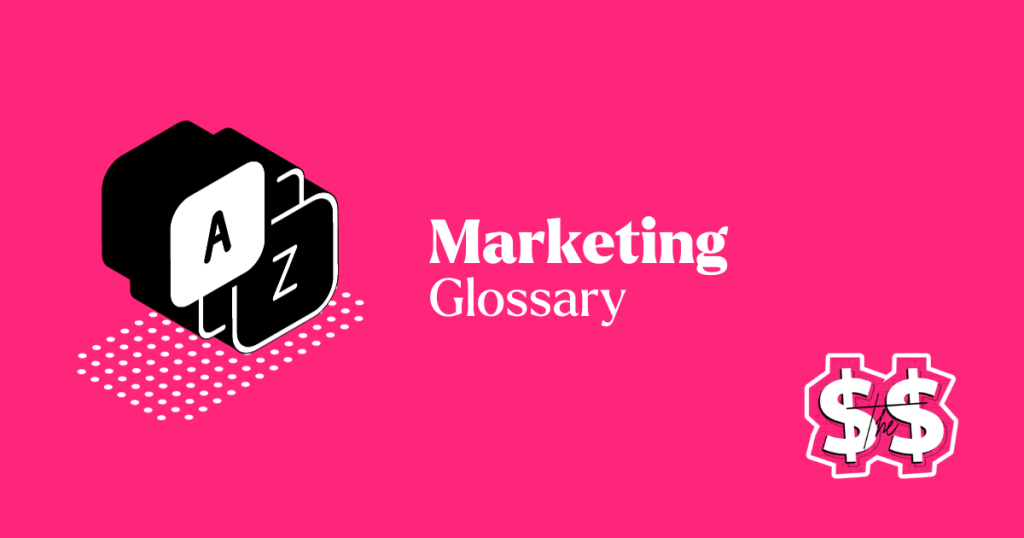Marketing is the process of promoting, selling, and distributing products or services to attract and retain customers.
- Marketing: The process of promoting, selling, and distributing products or services to attract and retain customers.
- Advertising: Paid communication to promote products, services, or brands.
- Brand: The unique identity and image associated with a company or product.
- Target Audience: The specific group of people or demographic that a marketing campaign aims to reach.
- Digital Marketing: Marketing efforts conducted through digital channels such as websites, social media, and email.
- SEO (Search Engine Optimization): Strategies and techniques to improve a website’s visibility on search engine results pages. (ref.: SEO glossary)
- Content Marketing: Creating and distributing valuable content to attract and engage a target audience. (ref.: content marketing glossary)
- Social Media Marketing: Promoting products or services through social media platforms. (ref.: social media glossary)
- Influencer Marketing: Collaborating with individuals with a significant following to promote a product or brand.
- Email Marketing: Sending targeted messages to a group of people through email. (ref.: email marketing glossary)
- ROI (Return on Investment): Measurement of the profitability of an investment relative to its cost.
- Segmentation: Dividing a market into distinct groups based on characteristics to tailor marketing efforts.
- Analytics: Analysis of data to gain insights into marketing performance and consumer behavior.
- Call to Action (CTA): A prompt that encourages the audience to take a specific action, like making a purchase.
- Conversion Rate: The percentage of visitors who complete a desired action, such as making a purchase.
- Lead Generation: The process of attracting and capturing potential customers’ interest in a product or service. (ref.: lead generation glossary)
- B2B (Business to Business): Marketing and transactions between businesses rather than between a business and individual consumers.
- B2C (Business to Consumer): Marketing and transactions directly between a business and individual consumers.
- SWOT Analysis: An assessment of a company’s Strengths, Weaknesses, Opportunities, and Threats.
- Viral Marketing: Marketing techniques that use pre-existing social networks to promote a product and create rapid awareness.
- Landing Page: A standalone webpage created for a specific marketing campaign.
- CRM (Customer Relationship Management): Strategies and tools to manage and analyze customer interactions and data.
- Market Research: The process of gathering, analyzing, and interpreting information about a market.
- Guerrilla Marketing: Unconventional and low-budget marketing tactics to gain maximum exposure.
- Demographics: Statistical data relating to the population and particular groups within it.
- CTV (Connected TV) Advertising: Advertising delivered to TVs via the internet, often on streaming services.
- KPI (Key Performance Indicator): Quantifiable metrics used to measure the success of specific marketing objectives.
- Persona: A fictional representation of an ideal customer based on market research and real data.
- A/B Testing: Comparing two versions of a webpage or marketing campaign to determine which performs better.
- Customer Retention: Strategies to keep existing customers and encourage repeat business.
- Market Segmentation: Dividing a market into subsets based on characteristics to tailor products or marketing.
- PPC (Pay-Per-Click): Online advertising model where advertisers pay a fee each time their ad is clicked.
- Ad Copy: The text of an advertisement, including headlines and body content.
- Call-to-Action (CTA) Button: A clickable button that encourages users to take a specific action, such as “Buy Now” or “Sign Up.”
- Heatmap: A graphical representation of data where values are depicted using colors to indicate intensity.
- Bounce Rate: The percentage of visitors to a webpage who navigate away without interacting. (ref.: bounce rate glossary)
- Remarketing: Targeted advertising directed at users who have previously visited a website.
- Algorithm: A set of rules or calculations used by search engines or social media platforms to deliver content.
- Chatbot: A computer program designed to simulate conversation with human users.
- UGC (User-Generated Content): Content created by users of a product or service, often shared on social media.
- Market Niche: A specialized segment of the market for a particular kind of product or service.
- Mobile Optimization: Adjusting websites and ads to ensure an optimal experience on mobile devices.
- Vlog: A blog in the form of a video, often used in influencer marketing.
- SMM (Social Media Management): Tools and strategies to manage and analyze social media accounts.
- SERP (Search Engine Results Page): The page displayed by search engines in response to a query. (ref.: SERPs glossary)
- Evergreen Content: Content that remains relevant and valuable over an extended period.
- Affiliate Marketing: Earning a commission by promoting other people’s products or services. (ref.: affiliate marketing glossary)
- Native Advertising: Advertisements that match the style and function of the platform they appear on.
- CPC (Cost-Per-Click): The cost an advertiser pays for each click on their ad.
- Geotargeting: Delivering content to a specific audience based on their location.
- Ad Impressions: The number of times an ad is fetched and displayed.
- Vanity Metrics: Metrics that look good but may not contribute to business goals.
- Churn Rate: The percentage of customers who stop using a product or service over a given period.
- Loyalty Program: A program designed to encourage repeat business by offering rewards.
- Micro-Influencer: An influencer with a smaller but highly engaged audience.
- Branding: The process of creating a unique name and image for a product or service.
- Market Penetration: The extent to which a product is recognized and accepted by customers in a particular market.
- CTV (Cost of Customer Acquisition): The cost associated with convincing a customer to make a purchase.
- CTR (Click-Through Rate): The percentage of people who click on an ad after seeing it.
- Inbound Marketing: Attracting customers through content and interactions rather than traditional advertising.
- Customer Persona: A detailed and semi-fictional representation of a company’s ideal customer.
- KOL (Key Opinion Leader): An individual who is seen as an authority in a particular industry or niche.
- Google Analytics: A web analytics service offered by Google to track and report website traffic.
- Customer Journey: The process a customer goes through when interacting with a brand.
- Chat Marketing: Marketing strategies implemented through messaging apps or chatbots.
- AIDA Model: A marketing model that describes the stages a consumer goes through: Attention, Interest, Desire, Action.
- Cohort Analysis: Analyzing the behavior of a group of users sharing common characteristics.
- Exit Intent Popup: A popup displayed when a user is about to leave a website.
- Lead Magnet: An incentive offered to potential customers in exchange for their contact information.
- Ad Network: A platform that connects advertisers with publishers to display ads.
- Multi-Channel Marketing: Using multiple marketing channels to reach customers across various touchpoints.
- Landing Page Optimization: Improving elements of a landing page to increase conversions and user engagement.
- Customer Acquisition Cost (CAC): The cost associated with acquiring a new customer.
- Ad Click: The action of clicking on an online advertisement.
- Mobile App Optimization: Enhancing the visibility and performance of a mobile app in app stores.
- Brand Equity: The perceived value and strength of a brand in the eyes of consumers.
- Customer Lifetime Value (CLV): The predicted net profit attributed to the entire future relationship with a customer.
- Ephemeral Content: Content that is temporary and disappears after a set period.
- Lead Scoring: Assigning a value to leads based on their behavior and likelihood to convert.
- PPC (Pay-Per-Click) Campaign: A marketing campaign where advertisers pay a fee for each click on their ads.
- ROI (Return on Investment): The ratio of net profit to the initial cost of an investment.
- Keyword Density: The percentage of times a keyword or phrase appears in a piece of content.
- Exit Rate: The percentage of visitors who exit a website after viewing a specific page.
- Branded Content: Content created or sponsored by a brand for promotional purposes.
- Conversion Funnel: The journey a potential customer takes from awareness to purchase.
- AI (Artificial Intelligence) in Marketing: The use of AI technology to automate and enhance marketing processes.
- Click Fraud: Illegitimate clicks on online ads with the intent to drain a competitor’s budget.
- A/B Testing: Comparing two versions of a webpage or marketing campaign to determine which performs better.
- Customer Segmentation: Dividing customers into groups based on shared characteristics for targeted marketing.
- UGC (User-Generated Content) Campaign: A strategic initiative to encourage users to create content that promotes a brand.
- Drip Marketing: Sending a series of pre-written messages to leads over time to nurture them.
- Push Notification: A message sent to a user’s device, often from a mobile app or website.
- PPV (Pay-Per-View) Advertising: A model where advertisers pay for each view of their content.
- Customer Feedback Loop: A continuous process of gathering and utilizing customer feedback to improve products or services.
- Dark Social: Social sharing that occurs privately, making it challenging to track.
- Brand Ambassador: An individual who represents and promotes a brand in a positive light.

Marketing is the strategic process of promoting and selling products or services. It involves understanding target audiences, creating compelling messages, and utilizing various channels, such as digital platforms and advertising, to engage customers. Successful marketing aims to satisfy consumer needs, build brand awareness, and drive sales, fostering lasting relationships between businesses and their clientele.
